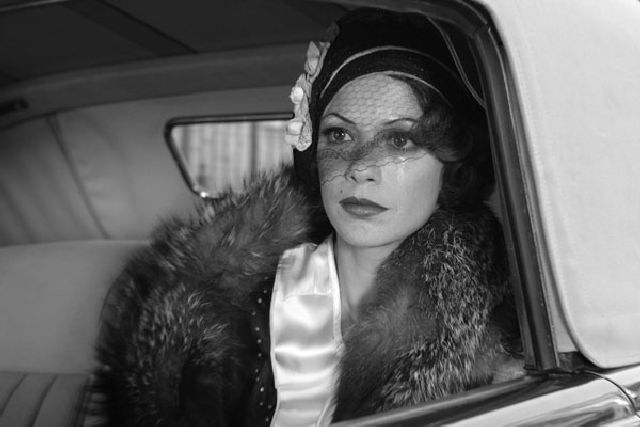The Artist (2011) 

Director: Michel Hazanavicius
Cast: Jean Dujardin, Berenice Bejo, John Goodman
Synopsis: A silent movie star meets a young dancer, but the arrival of talking pictures sends their careers in opposite directions.
Very often, films like Michael Hazanavicius’s The Artist, which enjoyed near unprecedented acclaim from all the critics, prove to be a disappoint upon viewing simply because the effusive praise that’s heaped upon them lifts our expectations to unrealistic levels. And also because many mainstream critics seem frightened of raising a dissenting voice for fear of being wrong. How many of them, one wonders, might be thinking, if all those other guys think it’s the coolest thing since the last coolest thing, then surely that’s what it must be. Every now and then, though, the universal praise is merited, and The Artist proves to be one of those occasions. It’s a very clever movie, and writer/director Hazanavicius has clearly put a lot of thought into playing with the theme of sound to amusing effect, but it’s not this that makes The Artist such an enjoyable watch, it’s the way that Hazanavicius’s obvious love for cinema shines through in every scene, and the manner in which he uses familiar tropes to mine unexpected depths of emotion.
Jean Dujardin, with whom Hazanavicius has already collaborated on the spoof OSS117 spy movies, plays George Valentin, a Douglas Fairbanks style idol of the silent screen. We first meet Valentin in the guise of one of his heroes, strapped to some electrical torture device, defiantly swearing that ’I won’t talk! I won’t say a word!’ His opening lines prove prophetic, and form the subject of the rest of the movie. The year is 1927, and the dawn of the era of sound lies just beyond the horizon. George, leading a lifestyle of opulent luxury, is at the top of his game. He’s dismissive of sound, refusing to accept it as a natural development of cinema.
At the premiere of his new movie, George bumps into Peppy Miller (Berenice Bejo), an aspiring young actress. The following day, Peppy is cast in a small role in George’s new movie, and the scene they share triggers a romantic attraction. George is already married, however, and although it is a loveless marriage, he remains faithful to his uncaring wife. Stubbornly refusing to yield to the inevitable, George finances his own silent movie which is released on the same day as Hollywood’s newest star – Peppy. George’s film bombs, and the Wall Street Crash wipes out the remainder of his fortune…
The story is as old as talking movies, and comparisons to Singin’ in the Rain (1952), which also deals with Hollywood’s tribulations over the switch to sound, are inevitable, especially as Dujardin shares a startling resemblance to Gene Kelly, the star of Singin’ in the Rain. The story also loosely mirrors that of silent heartthrob John Gilbert, whose career nosedived around the time that sound was introduced, although largely for reasons unrelated to the advent of sound. It’s an appropriately old-fashioned (but warm-hearted) melodrama, which relies heavily on the likeability of Dujardin. He shoulders the burden with a deceptive ease, effortlessly evoking the aura of those long-ago stars from Hollywood’s golden era. The lack of sound somehow conspires to show how good an actor Dujardin is, whether it’s capturing the same expression for numerous takes of the same scene in a movie he‘s working on, or the very real despair of a man unable to swallow the pride he knows is sure to destroy him. Bejo, the wife of Hazanavicius, is equally as sympathetic as the ambitious but warm-hearted Peppy.
Knowledgeable fans of old movies will find an added element of enjoyment from identifying the numerous references to classic movies. The sequence of breakfast scenes in which George grows increasingly disenchanted with his marriage to Doris (Penelope Ann Miller) are an homage to a similar sequence in Orson Welles’ Citizen Kane (1941), and the music that accompanies Peppy’s desperate dash to be with George at his lowest ebb is borrowed from Alfred Hitchcock’s Vertigo (1958). And for a silent movie Hazanavicius makes incredibly imaginative use of – and references to – sound: a dream sequence in which George is staggered to hear sound effects intruding on his silent world culminates with the image of a feather falling to the ground with an ear-splitting explosion; the way that the dialogue – when it finally arrives – begins with the word ’cut!’ and ends with the word ’action!’ Especially amusing for the more observant viewers is John Goodman (playing a gruff but lovable studio boss) dropping a silent F-bomb – a practice which was fairly common in the movie’s early years until lip readers began complaining…
Movies like this depend on their creator possessing an abiding passion for their subject matter, and it’s clear that Hazanavicius has an over-abundance of that passion. The Artist is a unique and special movie: a love letter to a world that seemed so much simpler and less hostile. At least we can revisit the movie as often as we like – even if that kinder world can never be reclaimed.
httpv://www.youtube.com/watch?v=OK7pfLlsUQM
